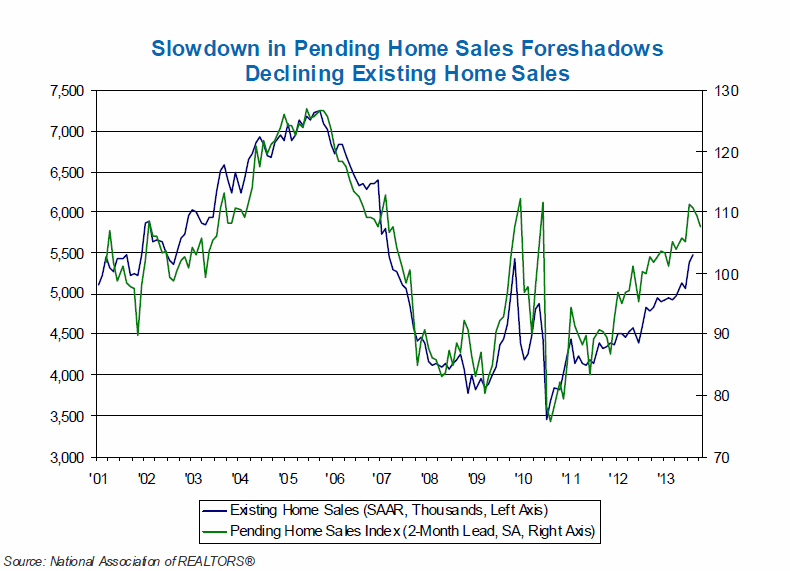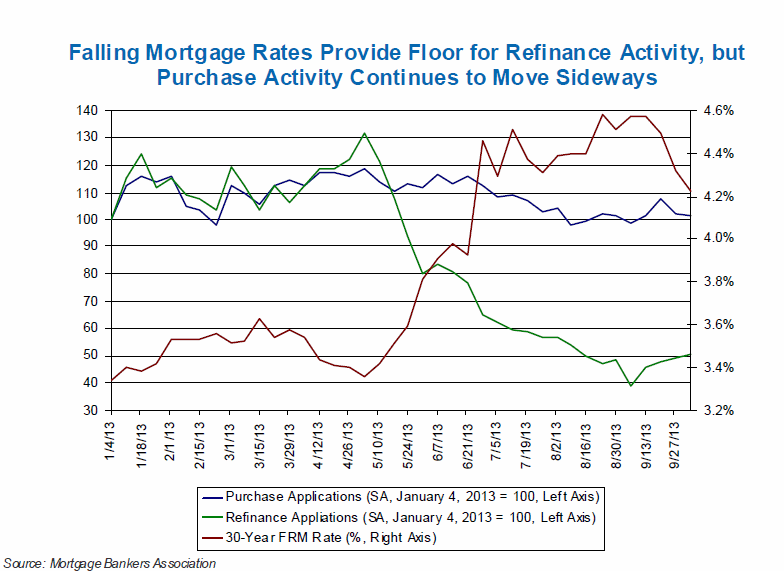Some of the gist of Fannie Mae's October Economic Forecast, released Thursday but written late last week, was made obsolete when the government shutdown ended last evening, but the company's economists did correctly peg the length of the episode and the ultimate outcome, Given that they did project a shutdown of two to three weeks and an eventual raising of the debt ceiling, their economic and housing market projections based on those guesses are still valid. Doug Duncan, Orawin T. Velz, and Brian Hughes-Cromwick lowered their estimate of economic growth in the fourth quarter from 2.5 to 2.0 percent, bringing full year growth to 1.9 percent compared to 2.0 percent in their last forecast.
The decision made by the Federal Reserve in September to maintain the pace of asset purchases has brought long-term interest rates back down and has cushioned some of the adverse impact of the shutdown and debt ceiling debates however it will not be enough to offset some near term weakening of momentum and fiscal headwinds. Fannie Mae's economists expect the Fed to start tapering next year and end its asset purchase program in the second half of 2014. They expect no funds rate hikes until Q3 2015 when they expect unemployment to decline near the magic Fed number of 6.5 percent.
Turning to housing, the economists expect mortgage rates to rise gradually through the year, averaging 4.4 percent in the fourth quarter and 5.0 percent a year from now, a figure 20 to 30 basis points lower than their projections last month.
Housing indicators have been generally positive. Existing home sales, possibly reflecting a rush to buy in the face of rising interest rates, rose to their highest level in six years. Pending home sales, however, declined in August for the third month, suggesting a pullback in sales in the fourth quarter. So far in 2013 home sales are nearly 12 percent above those in 2012 so even if they decline sharply in the fourth quarter they will still probably finish the year up 10 percent, slightly stronger than the September forecast.

Home starts were also up in August from several disappointing prior months and single family permits rose for the fourth time in five months. Multifamily starts and permits were both down.
The authors say they do not expect the recent easing of mortgage rates to revive the refinancing boom but it should provide another window of opportunity for homeowners. Some appear to be taking advantage of it according to Mortgage Bankers Association numbers. Purchasing activity however has seen limited improvement.
The three say if the shutdown lasts less than a month, which it did, the impact on the mortgage market should be limited. The FHA and VA continued to process new loans despite reduced staff as did lenders with delegated FHA authority. The shutdown did affect small FHA lenders as well as issuances through Ginnie Mae.
As the result of an annual benchmark to recently released Home Mortgage Disclosure Act (HMDA) data for 2012 Fannie Mae has increased its estimate of total mortgage originations in 2012 by $127 billion to $1.25 trillion which, along with the lowering estimate of interest rates, led to higher trajectories for originations this year and next. For all of 2013 they expect total mortgage originations to fall about 15 percent to $1.83 trillion and refinancing to drop 10 percentage points from an estimated 72 percent in 2012.
With expected rising mortgage rates through 2014, refinancing originations are projected to decline further, outweighing the expected increase in purchase mortgage originations, bringing total mortgage originations down to $1.36 trillion in 2014. Total single-family mortgage debt outstanding fell 1.8 percent annualized in the second quarter against their expectation of an increase, and leading to a downgrade of their forecast to a small decline in 2013, the sixth consecutive annual drop.








